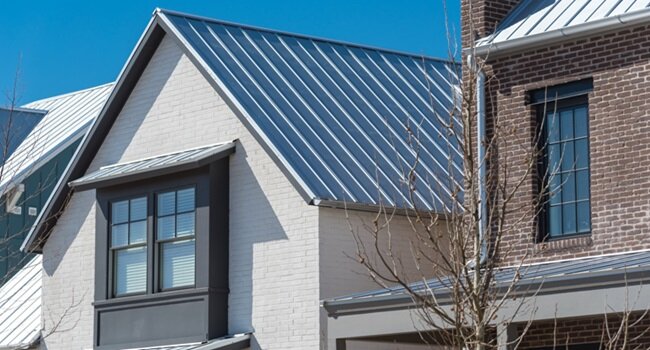When it’s time to replace your roof, the material you choose makes a difference in both the short and long term. Metal roofing is popular due to its durability, energy efficiency, and aesthetic appeal. Whether you’re updating an older home or constructing a new one, metal roofing can offer several practical advantages. In this article, we’ll explore eight key advantages metal roofs offer homeowners, helping you decide if this option fits your needs.
1. Longevity and Durability
Metal roofs are known for their impressive lifespan. Unlike asphalt shingles, which typically require replacement within two decades, metal roofs can last as long as 70 years or more, depending on the material and how well they’re installed. Their durability comes from their ability to resist harsh weather conditions, such as strong winds, heavy rain, and even hail. Metal roofing is also less likely to corrode or crack, meaning fewer repairs and overall maintenance throughout its life. This durability makes metal roofing a one-time investment for many homeowners.
2. Energy Conservation
A major advantage of metal roofing is its energy efficiency. Metal roofing helps reflect sunlight, which can lead to noticeable reductions in cooling costs during warmer months. This reflective property is particularly useful in hot climates, where energy bills for air conditioning can quickly add up.
Many metal roofing systems come with additional coatings that enhance their energy efficiency even further. These coatings improve reflectivity and help maintain a stable indoor temperature, leading to year-round energy savings. Over time, this reduction in energy use can lead to substantial cost savings.
3. Low Maintenance Requirements
Metal roofing offers a hassle-free experience for homeowners when it comes to upkeep. It doesn’t crack, warp, or succumb to pests like some other materials do. Metal roofs generally stay in good shape with occasional inspections and light cleaning. This is a stark contrast to materials like wood, which can be susceptible to rot, or tile, which may break and require regular attention. The fewer repairs and less frequent maintenance make metal roofing a practical choice, particularly for those who prefer minimal upkeep.
4. Environmental Impact
If you’re aiming for an environmentally conscious roofing choice, metal roofs stand out for their sustainability. They are often made from recycled materials and can be fully reused when they reach the end of their lifespan. This is unlike traditional roofing materials that often contribute to landfill waste. Additionally, the energy efficiency of metal roofs helps lower your household’s energy consumption, reducing your environmental footprint. By opting for a metal roof, you contribute to less waste and a more energy-efficient home.
5. Fire Resistance
In regions where wildfires or house fires are a concern, metal roofing can provide extra peace of mind. Metal is a non-combustible material, which means it won’t catch fire from airborne embers or direct flames. This can make a significant difference in the event of a fire, particularly in areas prone to dry conditions and high winds, where embers can travel far distances. Some metal roofs also come with fire ratings, giving you additional assurance that your home has a higher level of protection against fire-related damage.
6. Variety of Styles and Customization Options
Metal roofing has come a long way in terms of design and aesthetic appeal. It’s no longer limited to a plain, industrial look. Today, you can find metal roofing in a wide range of colors, textures, and finishes, allowing you to customize it to match the style of your home. Some metal roofs even mimic the appearance of traditional roofing materials like slate, clay, or wood, offering the best of both worlds: the look you want with the performance you need. This flexibility in design helps improve curb appeal and fits a variety of architectural styles.
7. Lightweight Design
One often-overlooked advantage of metal roofing is its lightweight design. Compared to heavy materials like concrete or tile, metal roofing puts less stress on the structure of your home. This can be particularly important if you’re re-roofing an older home that might not be able to support the weight of traditional roofing materials. The lighter load also means the installation process is typically faster and easier, which can reduce labor costs. In some cases, metal roofing can even be installed directly over existing shingles, eliminating the need for tear-offs.
8. Increased Home Value
Installing a metal roof can positively impact your home’s resale value. Homebuyers are often attracted to metal roofs because they know they won’t have to worry about roof replacement for decades. The low-maintenance aspect, combined with energy efficiency and durability, can make your home stand out on the market. Additionally, homes with metal roofs tend to have better insurance ratings, as they offer better protection against fire, weather damage, and general wear. This can be an added selling point when you’re ready to put your home on the market.
Key Takeaways

Metal roofing offers many advantages, from its long lifespan to its energy efficiency. It requires minimal maintenance, provides excellent fire protection, and contributes to environmental sustainability. With its variety of styles and lightweight design, metal roofing can meet the needs of homeowners who want both performance and aesthetics. Moreover, the increase in home value makes metal roofing a smart investment, offering both immediate benefits and long-term returns. If you’re thinking about upgrading your roof, metal roofing is worth serious consideration.





























